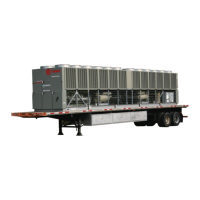RLC-SVX02G-E4
62
Unit Shutdown Procedures
Temporary Shutdown and
Restart
To shut the unit down for a short
time, use the following procedure:
1. Press the STOP key on the
CH.530. The compressors will
continue to operate and, after
unloading for 20 seconds, will
stop when the compressor
contactors de-energize.
2. Stop the water circulation by
turning off the chilled-water
pump after at least one minute.
To restart the unit after a temporary
shutdown, enable the chilled-water
pump and press the AUTO key. The
unit will start normally, provided the
following conditions exist:
•
The CH.530 receives a call for
cooling and the differential-to-start
is above the set point.
•
All system operating interlocks
and safety circuits are satisfied.
Under freezing conditions, the
chilled water pump must remain in
operation during the full shutdown
period of the chiller if the chilled
water loop does not contain glycol,
to prevent any risk of evaporator
freeze-up. Refer to charts 1 and 2.
Extended Shutdown
Procedure
The following procedure is to be
followed if the system is to be taken
out of service for an extended
period of time, e.g., seasonal
shutdown:
1. Test the unit for refrigerant leaks
and repair as necessary.
2. Open the electrical disconnect
switches for the chilled-water
pump. Lock the switches in the
“OPEN” position.
Lock the chilled-water pump
disconnects open to prevent pump
damage.
3. Close all chilled-water supply
valves. Drain the water from the
evaporator.
4. Open the unit main electrical
disconnect and unit-mounted
disconnect (if installed) and lock
in the “OPEN” position.
Lock the disconnects in the “OPEN”
position to prevent accidental
startup and damage to the system
when it has been set up for
extended shutdown.
5. At least every three months
(quarterly), check the refrigerant
pressure in the unit to verify that
the refrigerant charge is intact.
During an extended shutdown
period, especially over the winter
season, the evaporator must be
drained of water, if the chilled water
loop does not contain glycol, to
prevent any risk of evaporator
freeze-up.
